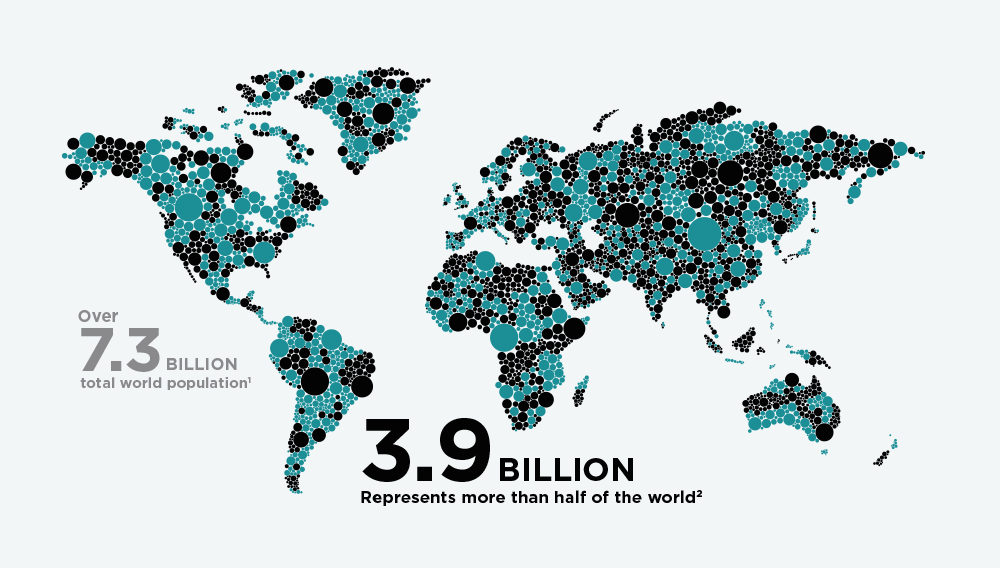

Licensed professionals can receive the latest Listerine clinical information and patient resources.
ORAL CONDITIONS ARE THE MOST COMMON CONDITIONS OF HUMANKIND1

Affecting 3.9 billion people, untreated oral disease is a worldwide issue affecting more than half of the population. According to the Global Burden of Disease Study (1900-2010), untreated tooth decay is the most common condition among 291 diseases. Holding rank as the 36th most prevalent condition, severe tooth loss affects an estimated 2% of the global population.2
The most common childhood disease is dental caries—and it’s on the rise.3 Dental caries can cause lasting harm to a child’s oral and general health, and impact social and intellectual development.3 Worldwide, between 60% and 90% of school age children have dental caries.4 The majority of dental decay remains untreated due to inappropriate, unaffordable, or unavailable oral healthcare services.1,4
Gingivitis is prevalent at all ages, and over 90% of the world’s population has chronic gingivitis to some degree.5 The prognosis is good if gingivitis is treated, but if not, it could progress to periodontitis and tooth mobility and tooth loss.5 Recently, there has been a shift in the global burden of oral conditions from severe tooth loss toward severe periodontitis and untreated caries.2
But contrarily, it is also possible that increases seen in untreated caries and severe periodontitis in younger age groups, in regions where oral healthcare may be compromised, could lead to increased tooth loss in these areas in the future.2 Severe periodontitis is the 6th most prevalent oral condition worldwide—affecting 5% to 20% of the adult population and 2% of our youths.2,4,6
Globally, complete tooth loss is pervasive, especially among older people.7 Worldwide, 30% of people ages 65 to 74 years have lost all of their natural teeth.7 Affecting quality of life, living without teeth can lead to unhealthy diets, malnutrition, and social isolation.1 Oral diseases and conditions can impact the ability to bite, chew, and swallow foods, even limiting food selection, which may lead to poor nutrition.8 According to self-reports, impact on social function can include limitations in verbal and nonverbal communication, social interaction, and intimacy.8
The Prevalence of Oral Disease Footnotes
References: 1. FDI World Dental Federation. Oral health worldwide. http://www.worldoralhealthday.com/wp-content/uploads/2014/03/FDIWhitePaper_OralHealthWorldwide.pdf. Accessed November 9, 2015. 2. Marcenes W, Kassebaum NJ, Bernabé E, et al. Global burden of oral conditions in 1990-2010: a systematic analysis. J Dent Res. 2013;92(7):592-597. 3. American Academy of Pediatric Dentistry. The state of little teeth. http://www.aapd.org/assets/1/7/State_of_Little_Teeth_Final.pdf. Accessed November 9, 2015. 4. World Health Organization. Oral health: what is the burden of oral disease? http://www.who.int/oral_health/disease_burden/global/en/. Accessed October 12, 2015. 5. Coventry J, Griffiths G, Scully C, Tonetti M. Periodontal disease. Brit Med J. 2000;321(7252):36-39. 6. Petersen PE, Bourgeois D, Ogawa H, et al. The global burden of oral diseases and risks to oral health. Bull World Health Organ. 2005;83(9):661-669. 7. World Health Organization. Oral health. Fact sheet No. 318. April 2012. http://www.who.int/mediacentre/factsheets/fs318/en/. Accessed November 9, 2015. 8. National Institute of Dental and Craniofacial Research. Oral health in America: a report of the Surgeon General (executive summary). http://www.nidcr.nih.gov/DataStatistics/SurgeonGeneral/Report/ExecutiveS.... Accessed July 9, 2015.



All Fields required, unless otherwise indicated
Personal Information
Step 1
Will be used as your user name
By submitting your information above, you agree that the information you provide will be governed by our site's Privacy Policy.